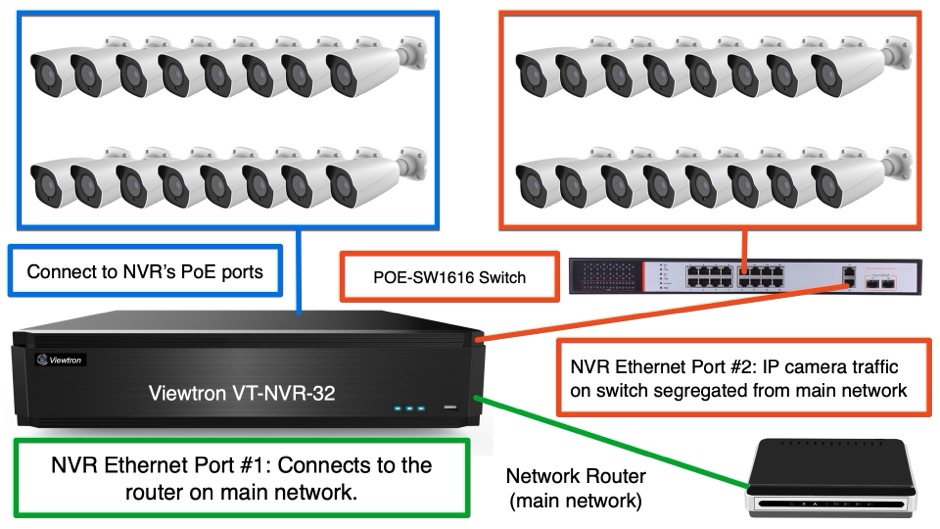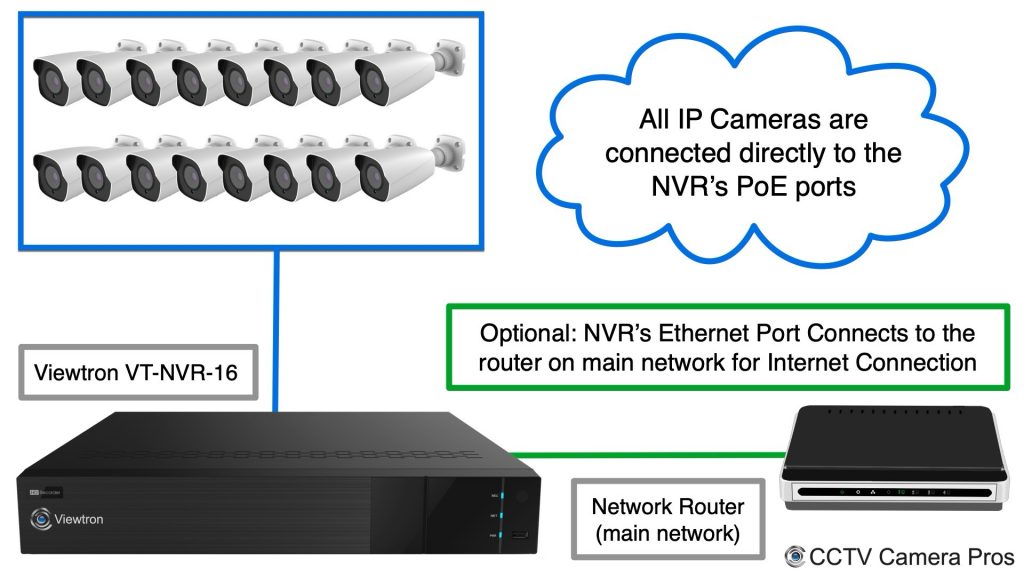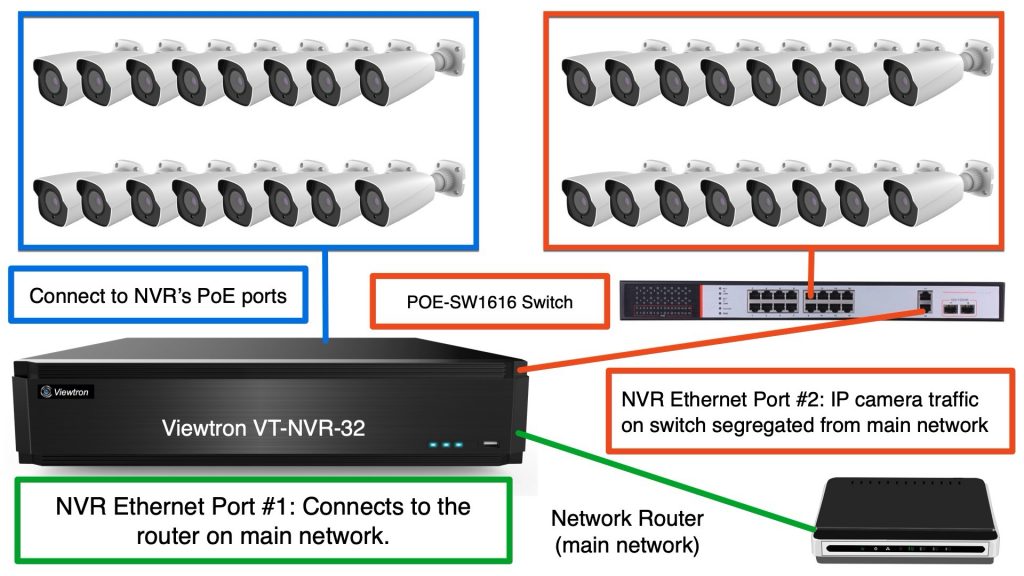Separating IP Camera Network Traffic from your Local Network
When setting up a security camera system for your home or business, it’s essential to understand the differences between traditional closed-circuit television (CCTV) systems and modern IP camera systems. I discuss the differences in detail and why I recommend Viewtron IP camera systems with AI software here.
In this video and article, I specifically want to discuss a common misconception that IP cameras always use network traffic on your main local area network (LAN). Some customers worry about how the additional network traffic from IP cameras can impact the performance of other IP devices on the network. This topic came up yesterday when I was speaking with a customer at CCTV Camera Pros. He mentioned to me that he ran RG59 Siamese coax cable for a brand new security camera system installation. He chose a CCTV camera system because the concern that he had about an IP camera system bogging down his business’s network.
Let’s explore how you can keep IP camera traffic separate from your main network while still enjoying the benefits of remote access to view and manage your security system.
Analog CCTV Systems vs. IP Camera Systems
Analog CCTV systems use coaxial cables (RG59) and BNC connectors to transmit video signals from security cameras directly to a DVR recorder. This creates a closed circuit TV system, meaning the video traffic does not pass through any network. On the other hand, IP camera systems use Internet Protocol (IP) to transmit video and data over a network, typically using CAT5e or CAT6 Ethernet cables and a switch or router.
While some may assume that IP camera systems always use bandwidth on the main network, this is not the case. IP camera traffic can be segregated from your primary LAN, ensuring that your surveillance system doesn’t interfere with your other network devices.
Separating IP Camera Traffic with PoE NVRs

One effective way to keep IP camera traffic off your main network is by using a Network Video Recorder (NVR) with built-in Power over Ethernet (PoE) ports. PoE allows you to transmit both power and data over a single Ethernet cable, simplifying installation and reducing the need for additional power outlets
When you connect IP cameras directly to the PoE ports on the NVR, the video traffic remains on a separated local network between the IP cameras and NVR. This means that the high-bandwidth video surveillance recording traffic does not impact your main network that you use at your home or office.
Connecting the NVR to Your Network for Remote Access
While the recording traffic is kept separate, you can still connect the NVR to your main network to enable remote access to your cameras. This allows you to view live footage and playback recorded video using mobile apps (for iPhone and Android) or desktop software (for Mac and Windows). This is illustrated in the above diagram with the Viewtron 16 channel NVR connected to the network router. The network router is used on the main home or office network in this example and can be connected to a Internet modem.
In this example, the network traffic required for remote access is significantly lower than the video recording traffic, and it only occurs when you request to view a camera or interact with the NVR remotely. The video resolution and compression that is typically used for remote security camera viewing is much lower that the video recording being done on the NVR. This means that connecting the NVR to your network for remote access purposes will have minimal impact on your overall network performance.
Please note that connecting an NVR IP camera system to a network router and Internet connection is optional. The above connection between the NVR and network router could be eliminated, which would essentially make this a closed loop system (not exposed to any external network).
Also note, in the above diagram I notated the hard wiring of all of the IP cameras with a single line between the IP cameras and NVR. In reality, each IP camera is individually hard wired to a PoE port on the NVR with a network cable (CAT5e or CAT6).
Using a Separate Network Switch for IP Cameras
Another option for segregating IP camera traffic is to use a dedicated network switch. This method is particularly useful for larger systems that require more cameras than the number of PoE ports available on the NVR. In the above network diagram, the Viewtron 32 channel NVR only has 16 built-in PoE ports. So an external 16 port PoE switch must be used to power and connect the additional 16 cameras to the NVR.
The Viewtron VT-NR-32 has two Ethernet connections (dual network interface ports) so that you may connect an external switch directly to one port and connect the other to a network router on your LAN. This allows the NVR to communicate with two separate IP networks. It allows all of the IP camera network traffic to communicate on a private network between the NVR and cameras. But, also allows you to connect the NVR to your network router so that you can access your NVR from you local network and remotely over the Internet. This assumes that the router is also connected to an Internet source, or that the router is also an Internet modem.
Again in this diagram, I am using a single line to represent the hard wired network connections between the IP cameras and the NVR. I did the same for the hard wired connections between the other 16 IP cameras and the external network switch. In reality, each camera is individually hard wired with a network cable to an NVR PoE port, or to a port on the external PoE switch.
**Important Note: if you do connect an external network switch to the 2nd network port on a Viewtron NVR, you must setup those IP cameras with static IP addresses. CCTV Camera Pros can help guide you with this if you have questions, or we can pre-configure static IP addresses on some of your IP cameras before we ship them to you.
Completely Isolating Your IP Camera System Network
Some customer may not require remote access to their IP camera system. CCTV Camera Pros has designed systems for some military and government customers that have a strict requirement that the camera system absolutely must be isolated from all other computer networks. In this scenario, you can still use an IP camera system by completely isolating the camera network. This is done by connecting the cameras directly to the NVR and not connecting the NVR to your main LAN. This configuration essentially creates a closed-circuit IP camera system, similar to a traditional CCTV setup.
Summary / Conclusion
Understanding the various ways to configure your IP camera system network is crucial for optimizing performance and ensuring that your surveillance traffic does not impact your other network devices. Whether you choose to use a PoE NVR or a separate network switch that is completely isolated, you can enjoy the benefits of an IP camera system without sacrificing network performance. This is true for all Viewtron IP cameras, including AI security cameras, facial recognition cameras, and license plate recognition cameras. By separating your IP camera traffic from your main LAN, you can maintain a high-performance surveillance system while still enjoying the flexibility and convenience of remote access when needed. If you have any questions or need further guidance on setting up your IP camera system, don’t hesitate to email me anytime at mike@cctvcamerapros.net.










